by Winding Pathways | Jun 10, 2017 | Birds, Nature, Wonderment
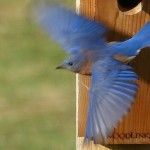
A male bluebird flies from the nest to bring back a snack for its mate.
Here’s a fun guest blog by friends, Gordon and Nancy, about their husbandry of birds on their “Little Acreage.”
“A few years ago my wife and I decided we wanted to attract wildlife to our little acreage. We already had deer and wild turkeys so we decided to try to attract some Bluebirds. We went on line to see where the best spot would be to place some houses to attract them.
“We then went to the Indian Creek Nature Center and bought a couple of houses. We felt that we needed the houses for bluebirds and the Center could use the donation. We placed four houses on the edge of the hay field.
“As time went on, all we saw were sparrows using the nest so we thought nothing would become of our houses. Then, a couple of years ago, a pair of Bluebirds started checking out the nest. But, we never found any eggs.
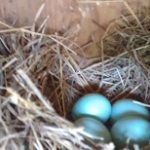
Four eggs! Photo: G&N Bena
“Earlier this year we looked in the house and nothing. A few days later we found these four eggs! What a great surprise for us. We now monitor the nest to watch the progress of our new friends.
Checking the other houses we found that a pair of wrens decided the house was satisfactory for their
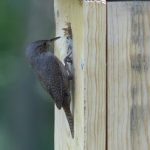
Feeding Young. Photo: G&N Bena
new home and I think they have at least seven eggs. We will be monitoring this nest, also. The other two houses have nests but I think they are sparrow nest. We decided to leave them because they need a home, also.”
Gordon and Nancy
Editor’s Note: Sialis.org has a fascinating set of pictures showing the progression of raising and fledging Bluebird young.
by Winding Pathways | Jun 8, 2017 | Birds, Garden/Yard, Nature
“Oh my gosh! I just found an ‘orphaned’ baby bird sitting on the front porch. What do I do?”
“There’s an ‘abandoned’ fawn in my hostas! What do I do?”
“Oh, the poor baby bunnies, they have no mom. What do I do?”
We get these type comments all the time at Winding Pathways. The short answer is: Do Nothing!
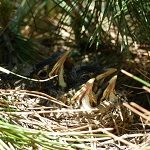
The babies are ready to “branch out!”
This summer millions of Americans will discover baby birds, fawns, bunnies, and a host of other seemingly helpless newborn animals in their yards and face the dilemma of “What do I do?”. Usually the baby is all alone with no mother in sight. It’s easy to assume the poor baby’s mother suffered a tragic fate and that the baby is doomed to an early death unless people “help” it.
We’ve often found baby bunnies and birds at Winding Pathways and we know the best way to help it is to leave them alone. A cottontail nest we found last spring is a good example.
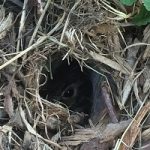
Female rabbits sometimes make a shallow nest in lawns. They leave the nest along and only return to nurse the young.
Cottontail mothers bear their young in a small hole they dig in the ground, frequently at the edge of a lawn or near a shrub. Mom knows that predators ranging from house cats to owls would love to dine on her babies, so she’s developed a sensible strategy to protect them. She stays away except for twice-a-day feedings.
If you see a cottontail sitting quietly on a spring or summer lawn there are good odds she’s above her nestlings and they’re enjoying breakfast or dinner of her rich milk. Stay away and keep your pets inside so she can complete her job. Other than at feeding time she stays away so predators don’t spot her and find the nest.
There’s a common misconception that if a human touches a baby fawn or bird it will be rejected by its mother. Not true! Maternal instinct is stronger than fear of people and many videos have shown fawns touched by people quickly reunited with their mothers. Birds have little or no sense of smell so can’t detect human scent. Still it’s not a good idea to touch a baby. The baby is likely a fledgling and learning to fly.
Many baby birds go through a growth phase we call “branchers”. Babies quickly outgrow space in the nest. When it’s too crowded they hop out and sit on a nearby branch, or a front porch, or a driveway. With the parent not visible it’s easy to assume the baby is orphaned or abandoned, but that’s hardly ever the case. It’s normal for parent birds to feed their young after they’ve left the nest, so mom and dad are probably out foraging and will return soon. The babies need energy and may be resting and waiting for a snack, so, again, keep pets and kids inside and stay away. Occasionally, placing the baby on a low branch may be appropriate in areas where there are lots of activity and the baby would be at risk of getting stepped on. Otherwise, leave the babies alone.
The best way to help wildlife babies is to stay away and quietly enjoy watching them from a distance. It’s likely you’ll soon see the parent or parents caring for its young.
by Winding Pathways | May 10, 2017 | Birds, Flowers/Grasses, Nature, Travel/Columns
May is about the most exciting month to travel and camp out in Iowa. We took in the Driftless area of Iowa and Wisconsin where we learned more about mounds at Effigy Mounds National Monument, ate at funky Café McGregor, took in Starks and Cabelas in Prairie du Chien, and entered our favorite forest over the “Forest Road” into Yellow River State Forest.
- Note our reviews and thoughts are independent, unpaid and unsolicited.
Enjoy this photo journal of our stay.
-
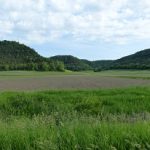
-
Fascinating terrain and vegetation characterize the Driftless Area.
-
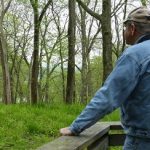
-
More questions than answers arise when investigating mounds.
-

-
Looking Down River
-
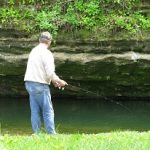
-
A great fishing spot.
-
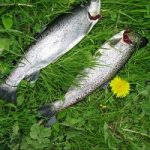
-
Fresh fish for dinner.
-
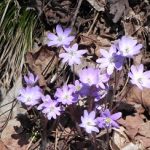
-
Spring is about a week later in northeast Iowa than central Iowa.
-
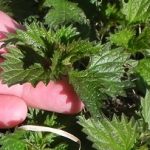
-
Nettles were a resource for Native Americans and still are for modern day foragers.
-
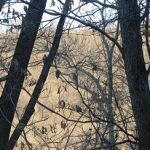
-
Last year’s young hang around as long as they can.
-
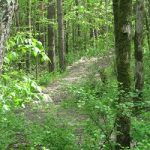
-
A favorite walk.
-

-
Season Five now open!
-
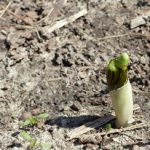
-
Tightly wrapped Mayapple pushes through the early spring ground.
-
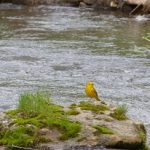
-
Birding is exceptional in May.
by Winding Pathways | Apr 22, 2017 | Birds, Flowers/Grasses, Nature, Trees/Shrubs, Wonderment
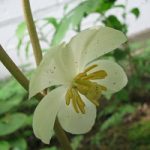
Beautiful blossoms hide under the umbrella-like leaves.
First submission in! Hey all, on Facebook Winding Pathways invited folks to submit a favorite spring photo – tree, scene, flower, animal – with a short write-up of why you like that picture. And, Kansas readers Emily and Zach Hemmerling have already replied! Way to Go!
Now, I’d love to have about a dozen more so send them in to our email and I’ll continue processing and then post. These samples of spring pictures. Join in the fun and share your descriptions!
-
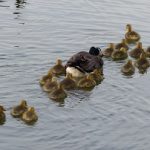
-
Photo – Protective custody
-
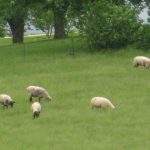
-
Photo of sheep in pasture
-
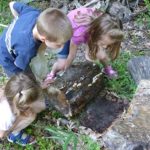
-
Kids develop strength, cooperation, and curiosity as they explore outside.
-
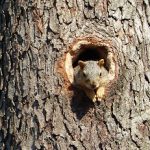
-
It’s a long way down, Mom.
-
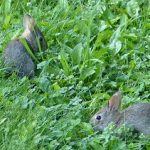
-
Bunnies are on their own as soon as the mother weens them.
-
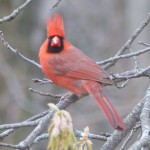
-
Photo – On a wild and windy day this Cardinal sang out his love song.
-
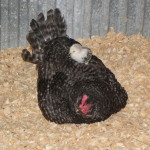
-
This mama hen with chick on her back fluffs up clean wood chips.
-
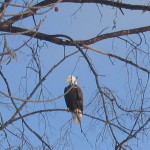
-
Eagle watching over nest.
-
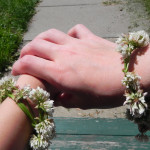
-
Clover bracelets
by Winding Pathways | Apr 18, 2017 | (Sub)Urban Homesteading, Birds, Nature
At Winding Pathways, we venture into our yard nearly every day, even if it’s raining, windy,
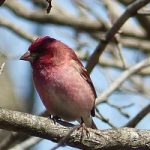
Some birds homestead at Winding Pathways.
or frigid out. Of all the times, early May is our favorite to linger outdoors. Why? It’s the best birding.
Very late April and the first couple of weeks of May boast normally glorious weather, blooming flowers and birds. Lots of birds, including those we can only enjoy for a fleeting week or two.
Here’s how we group the birds that we enjoy in our yard. Odds are the same or similar species follow this pattern in backyards with good habitat across much of the continent.
THE HOMEBODIES
Some birds don’t migrate. They brave the cold and grace winter feeders. In summer, they often raise broods of babies on the edge of the yard. These include titmice, chickadees, cardinals, nuthatches, house sparrows, and many woodpeckers.
THE NORTHERNER
Juncos are almost always under our feeders all winter gleaning seeds. To a Junco Iowa is the balmy south with a “warm” winter. Around mid-April they head north to nest in the boreal forests of Canada and Minnesota. We won’t see them again until around Halloween.
THE LOCALS
Many people consider the first sighting of a Robin to be a sign of spring. They assume the birds just arrived from the south. Robins, and closely related bluebirds, aren’t ambitious migrants. As the weather cools each fall, they abandon suburbia and move to nearby brushy areas for the winter. Winter Robins are common in orchards, the edges of farm fields, and wherever they can find dry and frozen fruit. These much-admired birds do a dietary switcheroo each year. Robins are famed worm eaters, and during warm months, they mostly eat insects and other invertebrates. In winter, they’re mostly vegetarians and dine on frozen berries. In years when fruit is scarce they’ll move south until they find suitable foraging.
THE HOMESTEADERS
Many birds are true migrants that winter far to the south but return north to raise a family. Among these true migrants are house wrens, rose breasted grosbeaks, orioles and indigo buntings. The homesteaders that nest at Winding Pathways have reached their northernmost destination but many of the same species simply rest and eat for a day or two before flying further north to nest. They are mere passersby.
THE AMBITIOUS MIGRANTS
Many birds are serious migrants that winter in South or Central America or the southern US and wing north to Canada and even Alaska to nest, only stopping to rest and eat for a day or two on their long journey. Many are warblers, although dozens of other bird species only use Winding Pathways as their “quick stop” on the way north. We can only enjoy the procession for a week or two in early May as the migrants stock up and then catch the next southerly winds to propel them to their nesting areas.
BIRDING AT ITS BEST
What’s remarkable about early May is the sheer diversity of birds that visit yards. It’s the best time to bring a cup of coffee and pair of binoculars outside. Sit quietly and look and listen to discover the amazing array of birds not possible observe in other seasons. A good bird book helps with identification but we often use the resources of the Cornell University Laboratory of Ornithology to help us identify and learn about birds. Their website at includes outstanding information that helps us determine species by both sight and sound and we frequently use their MERLIN phone app when we’re hiking or camping.
by Winding Pathways | Apr 4, 2017 | Birds, Nature
Rich made a New Year’s resolution to walk around Cedar Lake at least 100 times in 2017 after making over 90 lake circuits last year. The 60-acre lake is near downtown Cedar Rapids, Iowa, and features a 1.7 mile long paved trail following its shore. Every day pedestrians and bicyclists share the trail with Canada Geese.
“Lake circuits are always interesting, and many migrating water and shore birds visit Cedar Lake, but I especially like watching changes in goose behavior as the months go by,” Rich said.
Many people hate Canada Geese, mostly because of the mess they leave on the trail and lawns. But geese are fascinating animals. Closely observing them gives insights into their rhythm of life.
Geese live a long time. A quarter century is possible, which is a much longer lifespan than enjoyed by most wild animals. They pair up when young and mate for life. When a mate dies, the survivor often re-mates. Geese seem to enjoy plenty of leisure and like to socialize, and few predators bother them.
All winter they mingle in large flocks that are mostly big family groups of goose couples and their offspring. However, by early March the groups split up and human walkers around the Lake see mostly goose couples. They loiter near the trail, swim a bit, and forage on grass and grain spilled from nearby rail cars. In very early spring the female makes a simple nest on the ground. It’s hidden but if you see a goose pair in March their nest is likely close by.
Every day or two the female visits her nest and lays an egg before joining her mate for a day of foraging. Once the clutch of four to a dozen eggs is complete, she’ll begin a five-week incubation. During this time trail walkers only see single geese, and that’s likely the gander. He’s keeping a close eye on the hidden nest and his patient mate sitting on her eggs. Approach the nest and he will try to drive you away.
By the end of April, give or take a couple of weeks, the eggs hatch and for the next few months the parents protect and teach their youngsters. Baby geese, or goslings, grow fast and by late summer are full size and look just like their parents. For the next six or seven months they’ll stay with their family until it’s time to form pairs and begin the nesting process next spring.
Canada Geese are abundant and few urban wildlife sights are as pleasing to us as a flock winging over downtown at sunset.
-
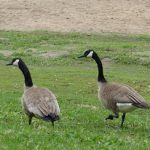
-
Geese pair up in the spring
-

-
Photo – Protective custody
-
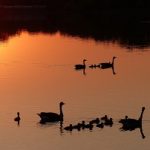
-
At sunset






























